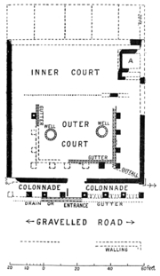
Ribchester
Encyclopedia
Ribchester is a village and civil parish
within the Ribble Valley
district of Lancashire
, England. It lies on the banks of the River Ribble
, 6 miles (10 km) northwest of Blackburn and 12 miles (19 km) east of Preston.
The village has a long history with evidence of Bronze Age beginnings. It is well known as a significant Roman site being the location of a Roman cavalry fort called Bremetennacum
; some parts of which have been exposed by excavation. In common with many towns and villages in East Lancashire its later history was dominated by cotton weaving; firstly in the form of hand loom weaving and later in two mills. Neither mill still operates and the village is primarily a dormitory village
for commuters to the town of Blackburn and cities of Preston and Manchester
.
The main access road into Ribchester is the B6245. From the north, this is the Preston Road, which merges into Church Street. From the east, it is the Blackburn Road, which, at its westernmost extremity, also links up with Church Street, albeit closer to the centre of the village.
auxiliary fort named Bremetennacum
or Bremetenacum Veteranorum. The first fort was built in timber in AD 72/73 by the Twentieth Legion. The fort was renovated in the late 1st century AD and was rebuilt in stone in the early 2nd century. During the life of the fort, a village grew up around it. A fort remained at Ribchester until the 4th century AD and its remains can still be seen around the present village.
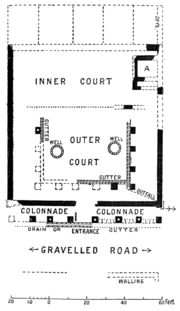 A report on Roman remains at Ribchester was published in Roman Britain in 1914 (Haverfield, 1915):
A report on Roman remains at Ribchester was published in Roman Britain in 1914 (Haverfield, 1915):
The most famous artifact discovered in Ribchester, and dating from the Roman period, is the elaborate cavalry helmet
. The helmet was discovered, part of the Ribchester Hoard, in the summer of 1796 by the son of Joseph Walton, a clog
maker. The boy found the items buried in a hollow, about three metres below the surface, on some waste land by the side of a road leading to Ribchester church
, and near a river bed. In addition to the helmet, the hoard included a number of patera
, pieces of a vase, a bust of Minerva
, fragments of two basins, several plates, and some other items that Townley thought had religious uses. The finds were thought to have survived so well because they were covered in sand. The hoard was thought to have been stored in a wooden box and consisted of the corroded remains of a number of items but the largest was this helmet. The hoard was sold to the British Museum by the cousin of Charles Towneley
.
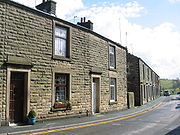
Little is known about post Roman Ribchester although the presence of Saint Wilfrid's Church
indicates that it retained some significance. When Henry VIIIs antiquary visited Ribchester in the 1540s he described it thus: 'Ribchestre ...hath been an auncient towne. Great squarid stones, voultes and antique coynes be found there...' When, a short while later, William Camden, author of Britannia (1586), visited the village, he recorded the saying that starts this section.
That the site of the Roman fort remained the focus of the village is indicated by the later building of Saint Wilfrid's Church very nearly over the Principia or headquarters area of the Roman Camp. The church's website provides a detailed history of both Saint Wilfrid's and St Saviour's Church
, which stands in the nearby settlement of Stydd
and which is perhaps a remnant of a Knights Templar or Knights Hospitallers establishment.
In the 17th and 18th Centuries the village became, like many in East Lancashire, a centre for cotton weaving. Initially in the homes of the weavers and latterly in two mills (Bee Mill and Corporation Mill) built on the Preston Road on the northern edge of the village.
In 1838 William Howitt published his Rural Life of England in which he described conditions in the weaving districts of East Lancashire. 'Everywhere extend wild, naked hills, in many places totally un-reclaimed, in others enclosed, but exhibiting all the signs of neglected spiritless husbandry ...Over these naked and desolate hills are scattered to their very tops, in all directions, the habitations of a swarming population of weavers... In Ribchester our chaise was pursued by swarms of [these] wooden-shod lads like swarms of flies and were only beaten off for a moment to close in upon you again, and their sisters showed equally the extravagance of rudeness in which they were suffered to grow up, by running out of the houses as we passed and poking mops and brushes at the horses heads. No one attempted to restrain or rebuke them; yet no one of the adult population offered you the least insult; and if you asked the way, gave you the most ready directions, and if you went into their houses, treated you with perfect civility and showed an affection for these little brats that was honourable to their hearts and wanted only directing by a better intelligence. The uncouthness of these poor people is not that of evil disposition, but of pressing poverty and continued neglect'
The weaving of cotton and other textiles continued in Ribchester until the 1980s when the last weaving business closed in Bee Mill.
The River Ribble is prone to extreme spates and this often leads to flooding in Ribchester during the winter months.
The Office of National Statistics gives the following land use for the Ribchester ward
.
The survey, which was conducted in January 2000, collected data from 500 households in the parish of Ribchester and produced data relating to 1244 people. The following demographic data is drawn from this survey.
81% of the sample were born in Lancashire; 4% were born in Yorkshire.
96% of the sample were born in England.
Approximately 75% of the sample travelled less than 10 miles (16 km) to work.
The UK Office of National Statistics shows a population estimate (in 2004) of 1,548 persons of whom 756 were male and 792 female.
The 2001 census for the Ribchester ward gives the following employment statistics:
There are three public house
s in the village: the White Bull, the Black Bull, and the Ribchester Arms, as well as a Sports and Social Club that was the working mens club associated with the mills. There is a small Spar shop, which occupies the site once occupied by the Cooperative Store and a tea room.
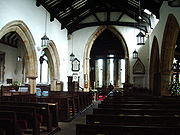 Saint Wilfrid's Church stands by the River Ribble on what was the centre of the Roman Fort. It is believed to have been founded by Saint Wilfrid in the 8th Century.
Saint Wilfrid's Church stands by the River Ribble on what was the centre of the Roman Fort. It is believed to have been founded by Saint Wilfrid in the 8th Century.
Saint Peter and Paul's Church is an early barn church. Nearby are alms houses and the Church of Saint Saviour.
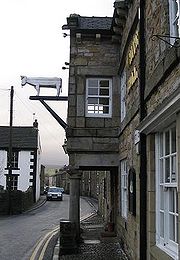
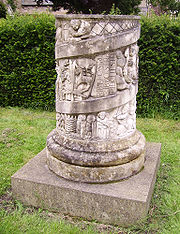 This is the result of a community project to create public art to commemorate the Millennium. Four sculptures, created by sculptor Fiona Bowley, are set in a garden leading from Church Street into the Village's playing field. The sculptures all reflect aspects of Ribchester life and history; they comprise: a sun dial, a column (modelled on Trajan's column in Rome) showing aspects of Ribchester history, a celebration of local myths and tales ('The Pig, the Ribber and the Devil') and finally a piece celebrating Ribchester's community spirit. The column has now fallen into disrepair as the base begins to break up due to poor quality stone.
This is the result of a community project to create public art to commemorate the Millennium. Four sculptures, created by sculptor Fiona Bowley, are set in a garden leading from Church Street into the Village's playing field. The sculptures all reflect aspects of Ribchester life and history; they comprise: a sun dial, a column (modelled on Trajan's column in Rome) showing aspects of Ribchester history, a celebration of local myths and tales ('The Pig, the Ribber and the Devil') and finally a piece celebrating Ribchester's community spirit. The column has now fallen into disrepair as the base begins to break up due to poor quality stone.
during their three-day visit to the village in September 1993.
 Opposite the White Bull Pub are a row of cottages noteworthy for their unusual configuration of windows. Built for the hand loom weavers they have three levels with a single window at the uppermost. Although it is commonly believed that the window in the top level is to illuminate the looms this may not be the case as the weaving would probably have been carried out in the lowest part of the house because of the size of the loom and the need for damp conditions to keep the cotton flexible.
Opposite the White Bull Pub are a row of cottages noteworthy for their unusual configuration of windows. Built for the hand loom weavers they have three levels with a single window at the uppermost. Although it is commonly believed that the window in the top level is to illuminate the looms this may not be the case as the weaving would probably have been carried out in the lowest part of the house because of the size of the loom and the need for damp conditions to keep the cotton flexible.
The most famous find, the Ribchester Helmet, is on show in replica but the original is in the British Museum collection.
There are three places of worship in Ribchester. They are Saint Wilfrids (which incorporates St Saviour's, Stydd) which is a Church of England Church within the Diocese of Blackburn. Saint Peter and Paul's Church in Stydd is a Catholic church coming under the Roman Catholic Diocese of Salford. There is also the Mission Church.
Ribchester and District Angling Club (RADAC) leases fishing on the Rivers Ribble and Hodder in the surrounding area.
The Ribchester Amateur Theatre Society (RATS) performs plays and pantomimes in the Parochial Church Hall.
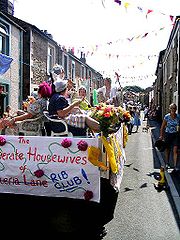 On the third weekend of June each year the village celebrates its annual Field Day. Such an event is common to the villages in the area where they are variously known as Club Days
On the third weekend of June each year the village celebrates its annual Field Day. Such an event is common to the villages in the area where they are variously known as Club Days
or Gala Days. The event consists, on the Saturday, of a parade of decorated floats and fancy dress classes around the village. Led by local brass bands the parade makes its way to playing fields at the side of the village where marquees and stalls provide entertainment for villagers and visitors and a location for art and craft competitions. Many streets in the village close themselves off at the end of the afternoon and have street parties. On the Sunday afternoon a village tea party takes place in the marquee.
The field day event marked its 50th anniversary in 2010.
Civil parish
In England, a civil parish is a territorial designation and, where they are found, the lowest tier of local government below districts and counties...
within the Ribble Valley
Ribble Valley
Ribble Valley is a local government district with borough status within the non-metropolitan county of Lancashire, England. Its council is based in Clitheroe. Other places include Whalley, Longridge and Ribchester. The area is so called due to the River Ribble which flows in its final stages...
district of Lancashire
Lancashire
Lancashire is a non-metropolitan county of historic origin in the North West of England. It takes its name from the city of Lancaster, and is sometimes known as the County of Lancaster. Although Lancaster is still considered to be the county town, Lancashire County Council is based in Preston...
, England. It lies on the banks of the River Ribble
River Ribble
The River Ribble is a river that runs through North Yorkshire and Lancashire, in northern England. The river's drainage basin also includes parts of Greater Manchester around Wigan.-Geography:...
, 6 miles (10 km) northwest of Blackburn and 12 miles (19 km) east of Preston.
The village has a long history with evidence of Bronze Age beginnings. It is well known as a significant Roman site being the location of a Roman cavalry fort called Bremetennacum
Bremetennacum
Bremetennacum was a Roman fort which is now the village of Ribchester in Lancashire . The site is a Scheduled Ancient Monument. The first Roman activity on the site was the establishment of a timber fort believed to have been constructed during the campaigns of Petillius Cerialis around AD 72/3...
; some parts of which have been exposed by excavation. In common with many towns and villages in East Lancashire its later history was dominated by cotton weaving; firstly in the form of hand loom weaving and later in two mills. Neither mill still operates and the village is primarily a dormitory village
Commuter town
A commuter town is an urban community that is primarily residential, from which most of the workforce commutes out to earn their livelihood. Many commuter towns act as suburbs of a nearby metropolis that workers travel to daily, and many suburbs are commuter towns...
for commuters to the town of Blackburn and cities of Preston and Manchester
Manchester
Manchester is a city and metropolitan borough in Greater Manchester, England. According to the Office for National Statistics, the 2010 mid-year population estimate for Manchester was 498,800. Manchester lies within one of the UK's largest metropolitan areas, the metropolitan county of Greater...
.
The main access road into Ribchester is the B6245. From the north, this is the Preston Road, which merges into Church Street. From the east, it is the Blackburn Road, which, at its westernmost extremity, also links up with Church Street, albeit closer to the centre of the village.
History
The earliest evidence of occupation in Ribchester is from the Bronze Age.Roman history
The village was originally established as a RomanRoman Empire
The Roman Empire was the post-Republican period of the ancient Roman civilization, characterised by an autocratic form of government and large territorial holdings in Europe and around the Mediterranean....
auxiliary fort named Bremetennacum
Bremetennacum
Bremetennacum was a Roman fort which is now the village of Ribchester in Lancashire . The site is a Scheduled Ancient Monument. The first Roman activity on the site was the establishment of a timber fort believed to have been constructed during the campaigns of Petillius Cerialis around AD 72/3...
or Bremetenacum Veteranorum. The first fort was built in timber in AD 72/73 by the Twentieth Legion. The fort was renovated in the late 1st century AD and was rebuilt in stone in the early 2nd century. During the life of the fort, a village grew up around it. A fort remained at Ribchester until the 4th century AD and its remains can still be seen around the present village.

- "In the spring of 1913 a small school-building was pulled down at Ribchester, and the Manchester Classical Association was able to resume its examination of the PrincipiaPraetorium- Etemology :The praetorium, also spelled prœtorium or pretorium, was originally used to identify the general’s tent within a Roman Castra, Castellum, or encampment. The word originates from the name of the chief Roman magistrate, known as Praetor...
(praetorium) of the Roman fort, above a part of which this building had stood. The work was carried out by Prof. W. B. Anderson, of Manchester UniversityUniversity of ManchesterThe University of Manchester is a public research university located in Manchester, United Kingdom. It is a "red brick" university and a member of the Russell Group of research-intensive British universities and the N8 Group...
, and Mr. D. Atkinson, Research Fellow of Reading College, and, though limited in extent, was very successful.
- "The first discovery of the Principia is due to Miss Greenall, who about 1905 was building a house close to the school and took care that certain remains found by her builders should be duly noted: excavations in 1906-7, however, left the size and extent of these remains somewhat uncertain and resulted in what we now know to be an incorrect plan. The work done last spring (1913) makes it plain (see illustration) that the Principia fronted — in normal fashion — the main street of the fort (gravel laid on cobbles) running from the north to the south gate. But, abnormally, the frontage was formed by a verandah or colonnade: the only parallel which I can quote is from CaerswsCaerswsCaersws is a village and community sitting on the River Severn, at miles west of Newtown, Powys, and halfway between Aberystwyth and Shrewsbury.- History & Amenities :...
, where excavations in 1909 revealed a similar verandah in front of the Principia. Next to the verandah stood the usual Outer Court with a colonnade round it and two wells in it (one is the usual provision): the colonnade seemed to have been twice rebuilt. Beyond that are fainter traces of the Inner Court which, however, lies mostly underneath a churchyard: the only fairly clear feature is a room (A on plan) which seems to have stood on the right side of the Inner Court, as at ChestersCilurnumCilurnum or Cilurvum was a fort on Hadrian's Wall mentioned in the Notitia Dignitatum. It is now identified with the fort found at Chesters near the village of Walwick, Northumberland, England...
and Ambleside. Behind this, probably, stood the usual five office rooms. If we carry the Principia about twenty feet further back, which would be a full allowance for these rooms with their walling, the end of the whole structure will line with the ends of the granaries found some years ago. This, or something very like it, is what we should naturally expect. We then obtain a structure measuring 81 × 112 feet (34.1 m), the latter dimension including a verandah 8 feet (2.4 m) wide. This again seems a reasonable result. Ribchester was a large fort, about 6 acres (24,281.2 m²), garrisoned by cavalry; in a similar fort at Chesters, on Hadrian's Wall, the Principia measured 85 × 125 feet (38.1 m): in the 'North Camp' at CamelonCamelonCamelon is a large settlement within the Falkirk council area, Scotland. The village is in the Forth Valley, west of Falkirk, south of Larbert and east of Bonnybridge...
, another fort of much the same size (nearly 6 acres), they measured 92 × 120 feet (36.6 m)."
The most famous artifact discovered in Ribchester, and dating from the Roman period, is the elaborate cavalry helmet
Ribchester Helmet
The Ribchester Helmet is a Roman bronze ceremonial helmet dating to between the late 1st and early 2nd centuries AD, which is now on display at the British Museum. It was found in Ribchester, Lancashire, England in 1796, as part of the Ribchester Hoard...
. The helmet was discovered, part of the Ribchester Hoard, in the summer of 1796 by the son of Joseph Walton, a clog
Clog
Clog may refer to:* clog , a shoe with a rigid, often wooden, sole* A blockage in plumbing* A British brand of rock-climbing equipment owned by Wild Country * Clogging, a traditional type of percussive folk dance...
maker. The boy found the items buried in a hollow, about three metres below the surface, on some waste land by the side of a road leading to Ribchester church
St Wilfrid's Church, Ribchester
-External links:...
, and near a river bed. In addition to the helmet, the hoard included a number of patera
Patera
A patera was a broad, shallow dish used for drinking, primarily in a ritual context such as a libation. These paterae were often used in Rome....
, pieces of a vase, a bust of Minerva
Minerva
Minerva was the Roman goddess whom Romans from the 2nd century BC onwards equated with the Greek goddess Athena. She was the virgin goddess of poetry, medicine, wisdom, commerce, weaving, crafts, magic...
, fragments of two basins, several plates, and some other items that Townley thought had religious uses. The finds were thought to have survived so well because they were covered in sand. The hoard was thought to have been stored in a wooden box and consisted of the corroded remains of a number of items but the largest was this helmet. The hoard was sold to the British Museum by the cousin of Charles Towneley
Charles Towneley
Charles Townley was an English country gentleman, antiquary and collector of the Townley Marbles ....
.
Post-Roman

Little is known about post Roman Ribchester although the presence of Saint Wilfrid's Church
St Wilfrid's Church, Ribchester
-External links:...
indicates that it retained some significance. When Henry VIIIs antiquary visited Ribchester in the 1540s he described it thus: 'Ribchestre ...hath been an auncient towne. Great squarid stones, voultes and antique coynes be found there...' When, a short while later, William Camden, author of Britannia (1586), visited the village, he recorded the saying that starts this section.
That the site of the Roman fort remained the focus of the village is indicated by the later building of Saint Wilfrid's Church very nearly over the Principia or headquarters area of the Roman Camp. The church's website provides a detailed history of both Saint Wilfrid's and St Saviour's Church
St Saviour's Church, Stydd
St Saviour's Church is an Anglican chapel in Stydd, a hamlet near Ribchester in Lancashire, England. It has been designated a Grade I listed building by English Heritage.-History:...
, which stands in the nearby settlement of Stydd
Stydd
The manor of Stydd is in the county of Lancashire. It is situated on the north eastern edge of the village of Ribchester. It boasts three notable buildings: Firstly St Saviour's Church. The Church's founding is obscure but it was well established by the time of the Knights Templar or Knights...
and which is perhaps a remnant of a Knights Templar or Knights Hospitallers establishment.
In the 17th and 18th Centuries the village became, like many in East Lancashire, a centre for cotton weaving. Initially in the homes of the weavers and latterly in two mills (Bee Mill and Corporation Mill) built on the Preston Road on the northern edge of the village.
In 1838 William Howitt published his Rural Life of England in which he described conditions in the weaving districts of East Lancashire. 'Everywhere extend wild, naked hills, in many places totally un-reclaimed, in others enclosed, but exhibiting all the signs of neglected spiritless husbandry ...Over these naked and desolate hills are scattered to their very tops, in all directions, the habitations of a swarming population of weavers... In Ribchester our chaise was pursued by swarms of [these] wooden-shod lads like swarms of flies and were only beaten off for a moment to close in upon you again, and their sisters showed equally the extravagance of rudeness in which they were suffered to grow up, by running out of the houses as we passed and poking mops and brushes at the horses heads. No one attempted to restrain or rebuke them; yet no one of the adult population offered you the least insult; and if you asked the way, gave you the most ready directions, and if you went into their houses, treated you with perfect civility and showed an affection for these little brats that was honourable to their hearts and wanted only directing by a better intelligence. The uncouthness of these poor people is not that of evil disposition, but of pressing poverty and continued neglect'
The weaving of cotton and other textiles continued in Ribchester until the 1980s when the last weaving business closed in Bee Mill.
Geography
The village is situated at the foot of Longridge Fell and on the banks of the River Ribble. The solid geography is of thick boulder clay deposits from the River Ribble over Sabden Shale. The area around the village shows signs of the river having moved with obvious terracing caused by the meanders.The River Ribble is prone to extreme spates and this often leads to flooding in Ribchester during the winter months.
The Office of National Statistics gives the following land use for the Ribchester ward
Wards of the United Kingdom
A ward in the United Kingdom is an electoral district at sub-national level represented by one or more councillors. It is the primary unit of British administrative and electoral geography .-England:...
.
| Land Use | Percentage |
|---|---|
| Domestic Building | 0.8 |
| Non-Domestic Building | 0.4 |
| Road | 1.3 |
| Domestic Garden | 2.3 |
| Green Space | 93.8 |
| Water | 0.7 |
Demography
In the year 2000 the Ribchester Millennium Projects Committee marked the millennium with the publication of a book entitled Ribchester: A Millennium Record. Its main aim was to record events during 2000 but as an adjunct to that it carried out a statistical survey of the village.The survey, which was conducted in January 2000, collected data from 500 households in the parish of Ribchester and produced data relating to 1244 people. The following demographic data is drawn from this survey.
81% of the sample were born in Lancashire; 4% were born in Yorkshire.
96% of the sample were born in England.
Approximately 75% of the sample travelled less than 10 miles (16 km) to work.
The UK Office of National Statistics shows a population estimate (in 2004) of 1,548 persons of whom 756 were male and 792 female.
The 2001 census for the Ribchester ward gives the following employment statistics:
| Employment | Percentage |
|---|---|
| Full Time | 39.2 |
| Part Time | 12.6 |
| Self Employed | 15.0 |
| Unemployed | 2.0 |
| Student | 6.0 |
| Retired | 16.6 |
| Home | 4.7 |
| Permanently Sick | 2.7 |
| Other | 1.3 |
Economy
The two mills that were the mainstay of the village in the early part of the 20th Century are closed. One, Corporation Mill, was demolished in the 1980s. The other, Bee Mill, is now home to a range of small businesses.There are three public house
Public house
A public house, informally known as a pub, is a drinking establishment fundamental to the culture of Britain, Ireland, Australia and New Zealand. There are approximately 53,500 public houses in the United Kingdom. This number has been declining every year, so that nearly half of the smaller...
s in the village: the White Bull, the Black Bull, and the Ribchester Arms, as well as a Sports and Social Club that was the working mens club associated with the mills. There is a small Spar shop, which occupies the site once occupied by the Cooperative Store and a tea room.
Saint Wilfrid's Church

Saint Peter and Pauls Church and Stydd Alms Houses
Although properly in the neighbouring settlement of StyddStydd
The manor of Stydd is in the county of Lancashire. It is situated on the north eastern edge of the village of Ribchester. It boasts three notable buildings: Firstly St Saviour's Church. The Church's founding is obscure but it was well established by the time of the Knights Templar or Knights...
Saint Peter and Paul's Church is an early barn church. Nearby are alms houses and the Church of Saint Saviour.

The Millennium Sculpture Garden

The White Bull
The White Bull Pub stands in the middle of the village and is well known for its portico, which is said to be supported by two pillars taken from the Roman fort. Above the portico is a rustic wooden representation of a white bull. The pub was patronised by the members of Time TeamTime Team
Time Team is a British television series which has been aired on Channel 4 since 1994. Created by television producer Tim Taylor and presented by actor Tony Robinson, each episode features a team of specialists carrying out an archaeological dig over a period of three days, with Robinson explaining...
during their three-day visit to the village in September 1993.
Weavers' Cottages

Excavated Roman Buildings
Adjoining the churchyard of Saint Wilfrid's Church are the excavated remains of the granaries which belonged to the Roman fort. A short distance east of the village and behind the White Bull pub, are the remains of the Roman baths.Roman Museum
Near to Saint Wilfrid's Church is the Roman Museum which has recently been refurbished and remodelled. The Museum houses many of the finds from the Roman fort.The most famous find, the Ribchester Helmet, is on show in replica but the original is in the British Museum collection.
Ribchester Bridge
Two miles upstream of Ribchester lies Ribchester Bridge. Rebuilt in the 1770s, after severe flooding damaged it, the bridge gives it name to a hornpipe published by a Thomas Marsden in his Collection of Original Lancashire Hornpipes, Old and New, issued in 1705.Religion
Census returns for Ribchester show that 86.7% of the population expressed themselves to be Christian with the majority of the remaining population professing no religion.There are three places of worship in Ribchester. They are Saint Wilfrids (which incorporates St Saviour's, Stydd) which is a Church of England Church within the Diocese of Blackburn. Saint Peter and Paul's Church in Stydd is a Catholic church coming under the Roman Catholic Diocese of Salford. There is also the Mission Church.
Sports and Recreation
Although Ribchester is a small community it has a number of local sports and recreational groups and facilities. Many of these are focussed on playing fields situated to the west of Church Street (alongside a lane called Popes Croft). These were the gift of a notable local family, the Openshaws. Ribchester Tennis Club have a pavilion and two hard tennis courts on the playing fields. There is a football pavilion which is the headquarters of the Ribchester Football Club. The playing fields also hold a large, well equipped, children's adventure play area.Ribchester and District Angling Club (RADAC) leases fishing on the Rivers Ribble and Hodder in the surrounding area.
The Ribchester Amateur Theatre Society (RATS) performs plays and pantomimes in the Parochial Church Hall.
Field Day

Club Days
Also known as a Gala Day or Field Day. An annual community celebration, common in rural communities in North West England, during which clubs, churches and other organizations process and gather for various activities such as competitions for fancy dress, arts and crafts, cooking and produce.Many...
or Gala Days. The event consists, on the Saturday, of a parade of decorated floats and fancy dress classes around the village. Led by local brass bands the parade makes its way to playing fields at the side of the village where marquees and stalls provide entertainment for villagers and visitors and a location for art and craft competitions. Many streets in the village close themselves off at the end of the afternoon and have street parties. On the Sunday afternoon a village tea party takes place in the marquee.
The field day event marked its 50th anniversary in 2010.
May Day Market
Each year the village organises a 'May Day Market' on the Spring Bank holiday when most of the village clubs, churches and charitable organisations set up and manage stalls as a means of raising funds to support their activities through the year. The market takes place on 'The Hillock' which is the small triangle of land outside the White Bull pub.Ribchester Festival of Music and Art
Usually held in June each year the festival brings internationally renowned musicians and performers to Ribchester for four or five days of performances. The majority of performances take place in Saint Wilfrids and Saint Saviours churches with additional events taking place in the pubs and around the Village.External links
- Vindolanda Tablets mentioning Ribchester Vindolanda Tablets Online
- Ribchester Museum
- Saint Wilfrid's Church
- Ribchester Parish Council
- Ribchester Local History Society
- Ribchester and District Angling Club
- Ribchester Saint Wilfrid's CofE Primary School
- Ribchester Tennis Club
- Ribchester Football Club
- Ribchester Amateur Theatre Society
- 'The Parish of Ribchester', A History of the County of Lancaster: Volume 7 (1912), pp. 36-44. British History Web Site
- Music for The Ribchester Bridge Hornpipe
- The Ribchester Roman Hoard (including Parade Helmet) at the British Museum

